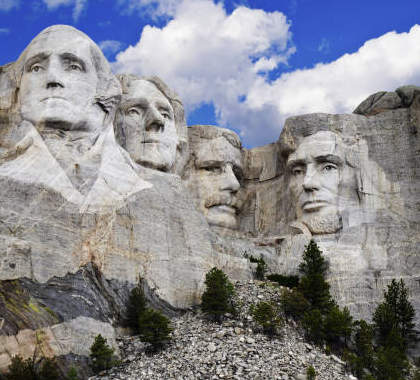Cities In South Dakota - Quick Facts, History & Geography
South Dakota Quick Facts
South Dakota became the 40th state of the United States on November 2, 1889. There are 390 places in South Dakota - 79 are CDP's, 156 are cities, 154 towns and 1 village. The South Dakota state nickname is "The Mount Rushmore State." The capital city of South Dakota is Pierre. The largest city is Sioux Falls with a population of 180,927. The iconic Mount Rushmore National Memorial, located in the Black Hills, features the sculpted faces of four U.S. presidents: George Washington, Thomas Jefferson, Theodore Roosevelt, and Abraham Lincoln. More than 2.5 million tourists visit the memorial every year. A monument dedicated to the Native American leader Crazy Horse is in the process of being completed. When completed, it will be the world's largest sculpture. Work began on the structure way back in 1948. South Dakota's economy is heavily based on agriculture, with livestock and crops like corn, soybeans, wheat, and sunflowers being prominent. The Sturgis Motorcycle Rally, one of the largest motorcycle gatherings in the world, takes place in Sturgis each year. The Badlands National Park is more than 244,000 acres in size. Hubert Humphrey, the 38th Vice President, was born in Wallace back in 1911. Belle Fourche, South Dakota is considered the geographic center of the United States. The name Dakota comes from a Sioux word that means "allies." South Dakota is the 17th largest state by land area and the 5th smallest state by population with under 1 million residents. Famous people from South Dakota include Tom Brokaw, January Jones, Adam Vinatieri, Mary Hart, Russell Means and Mary Hart.
The History of South Dakota
Long before any other exploration, South Dakota was inhabited by various Native American tribes, including the Dakota Sioux, Lakota Sioux and Nakota Sioux. In 1804, the Lewis and Clark Expedition explored the area, documenting its landscapes and interactions with Native American groups. South Dakota was initially part of the Dakota Territory, established in 1861. The quest for statehood gained momentum, and in 1889, South Dakota was admitted as the 40th state of the United States. The discovery of gold in the Black Hills in the 1870s led to significant migrations of prospectors, settlers, and miners. Throughout the 19th century, conflicts and negotiations between Native American tribes and the U.S. government resulted in a series of treaties, land cessions and reservations. In 1890, the tragic Wounded Knee Massacre took place on the Pine Ridge Indian Reservation. It marked a dark chapter in U.S. history and highlighted tensions between Native Americans and the U.S. government. The construction of Mount Rushmore National Memorial began in 1927 under the direction of sculptor Gutzon Borglum. It features the faces of four U.S. presidents and has become an iconic symbol of the nation. South Dakota has evolved into a state with a strong agricultural economy, educational institutions and a diverse cultural landscape. The state's history, both triumphs and challenges, remains an integral part of its identity.
The Geography of South Dakota
South Dakota is bordered by 6 states: North Dakota, Minnesota, Iowa, Nebraska, Wyoming and Montana. The eastern part of South Dakota is characterized by vast prairies that stretch as far as the eye can see. The Missouri River flows through the central part of the state, providing essential water resources for both agriculture and urban areas. Situated in the southwestern part of the state, the Black Hills are a mountain range known for their rugged beauty and cultural significance. In the southwestern part of the state, the Badlands National Park showcases a unique landscape of eroded buttes, pinnacles and otherworldly rock formations. South Dakota is dotted with numerous lakes and reservoirs, offering recreational activities such as boating, fishing and camping. In the northeastern corner of the state, the Glacial Lakes Region includes a chain of clear and pristine lakes formed by retreating glaciers. The Pine Ridge Indian Reservation is located in the southwestern part of the state, this reservation is characterized by its distinctive geography and culture. It's home to the Oglala Sioux Tribe and has played a significant role in Native American history.
South Dakota Relocation Information
Cities in South Dakota are sparsely populated and the rugged state that has several incredibly beautiful places for a permanent move. First of all, the Badlands National Park is one of the most scenic places in the United States. In the rugged landscape of the Badlands, you are likely to see animals such as bighorn sheep, coyotes, pronghorn and eagles. Also, the Black Hills area in the southwest part of the state is a fabulous destination with lots of events and attractions. The hills are of great religious importance to local American Indian tribes, and Mount Rushmore is located within the Black Hills.
South Dakota cities have a continental climate with really cold, dry winters and hot, humid summers. You can expect the temperature in most South Dakota cities to stay below freezing through most of the winter. As far as jobs and economy goes, the job market is not great in South Dakota. South Dakota's economy is the fifth smallest in the United States, and over 13% of South Dakota's population lives below the poverty line. The largest segment of the state's economy is made up of jobs in the service industry. Other important industries include government jobs, agriculture and tourism. On the upside, cost of living in South Dakota is also low, and taxes are the lowest in the nation. There is no state income tax in South Dakota and sales tax is only 4%.
For the most part, cities in South Dakota are very safe. Crime in South Dakota cities is almost identical to the national average. Larger cities like Sioux Falls and Rapid City do have higher crime rates, but that is to be expected from cities of their size.

